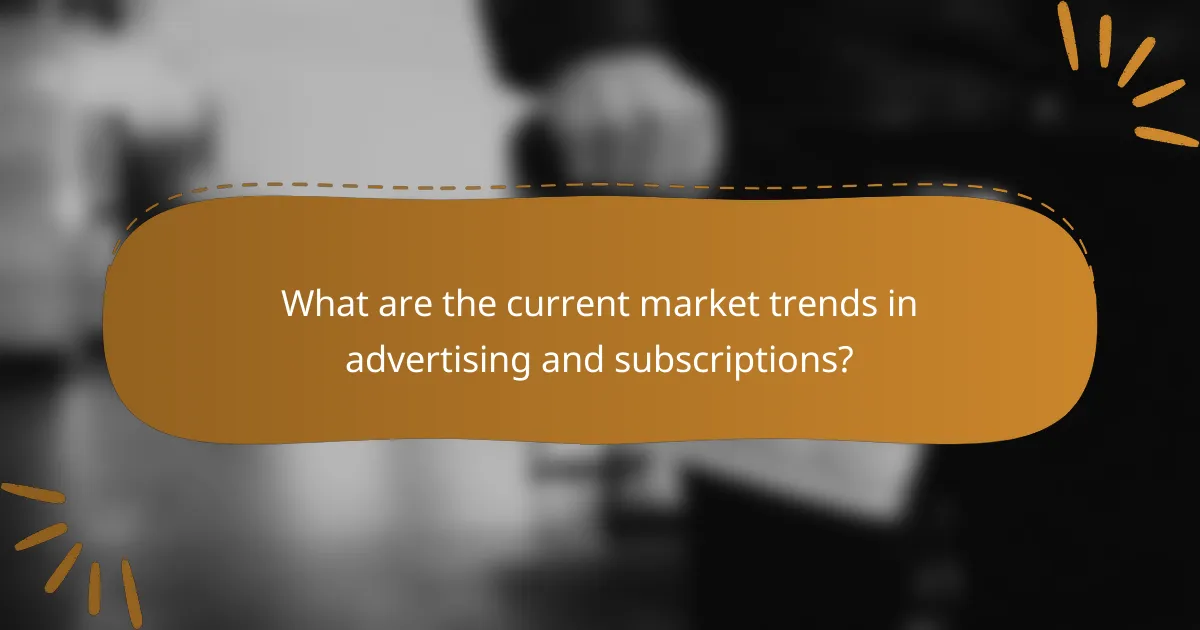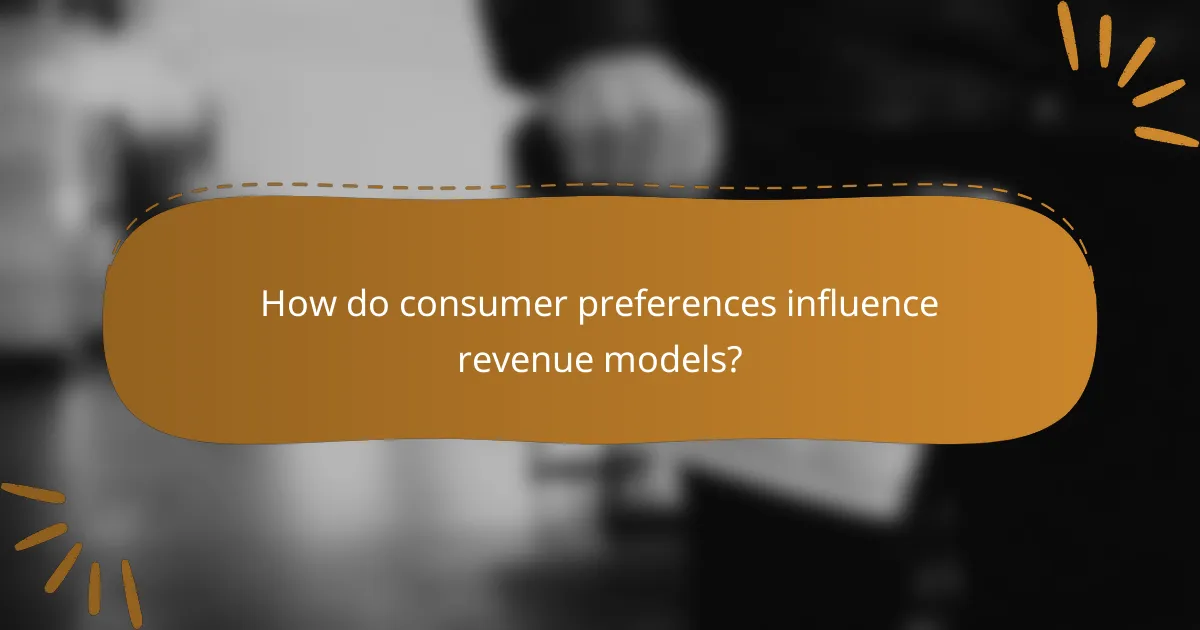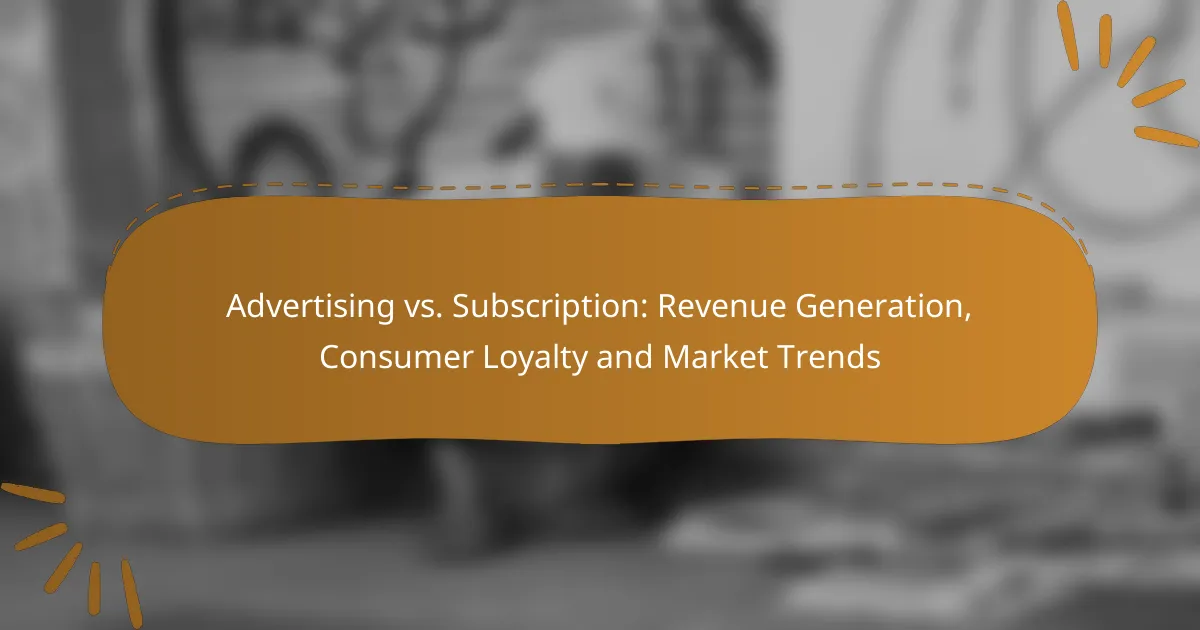In the evolving landscape of revenue generation, advertising and subscription models offer distinct advantages and challenges. While advertising focuses on capturing consumer attention to drive brand engagement, subscription models foster deeper loyalty by providing ongoing value and a sense of commitment. Understanding these dynamics is crucial for businesses aiming to navigate market trends and enhance consumer relationships.

How do advertising and subscription models generate revenue?
Advertising and subscription models generate revenue through distinct mechanisms. Advertising relies on attracting viewers to sell their attention to brands, while subscription models charge consumers directly for access to content or services.
Display advertising revenue streams
Display advertising generates revenue primarily through impressions and clicks. Advertisers pay based on the number of times their ads are displayed (CPM) or the number of clicks they receive (CPC). This model can be lucrative for platforms with high traffic, as they can command higher rates for premium placements.
Additionally, programmatic advertising allows for automated buying and selling of ad space, optimizing revenue based on real-time data. Advertisers often target specific demographics, enhancing the effectiveness of their campaigns and increasing potential revenue.
Subscription revenue mechanisms
Subscription revenue is generated by charging users a recurring fee for access to content or services. This can be structured as monthly or annual payments, providing predictable income for businesses. Examples include streaming services, software subscriptions, and membership sites.
To maximize revenue, companies often offer tiered pricing models, allowing customers to choose from different levels of access or features. This flexibility can attract a wider audience and enhance customer retention.
Comparative revenue analysis
When comparing advertising and subscription models, it’s essential to consider customer engagement and loyalty. Subscription models typically foster stronger consumer loyalty, as users are invested in ongoing access. In contrast, advertising models may experience fluctuating revenues based on viewer engagement and market conditions.
While advertising can yield higher short-term revenue during peak traffic periods, subscription models often provide a more stable long-term income stream. Businesses must evaluate their target audience and content type to determine which model aligns best with their goals.
Market share insights
The market share of advertising versus subscription models varies by industry. In digital media, subscription services have gained significant traction, with many consumers preferring ad-free experiences. Conversely, traditional media outlets still rely heavily on advertising revenue.
Emerging trends indicate a shift towards hybrid models, combining both advertising and subscription elements. This approach allows companies to diversify revenue streams while catering to different consumer preferences, ultimately enhancing market competitiveness.

What are the benefits of display advertising for consumer loyalty?
Display advertising can enhance consumer loyalty by increasing brand recognition and fostering engagement through visually appealing content. By consistently showcasing products or services, brands can create a lasting impression that encourages repeat interactions.
Brand visibility and engagement
Display advertising significantly boosts brand visibility by placing ads on various platforms where potential customers spend their time. This exposure helps brands stay top-of-mind, making it more likely that consumers will choose them when making purchasing decisions.
Engagement is another crucial aspect; interactive display ads can invite users to click through for more information, thus deepening their connection with the brand. For example, a well-designed banner ad featuring a special offer can entice users to explore a website further, increasing the likelihood of conversion.
Targeted advertising advantages
Targeted advertising allows brands to reach specific demographics based on user behavior, interests, and preferences. This precision means that ads are more relevant to the audience, which can lead to higher engagement rates and improved consumer loyalty.
For instance, a fitness brand can target ads to individuals who have shown interest in health-related topics, ensuring that the message resonates with the right audience. By tailoring content to meet the needs and desires of specific consumer segments, brands can foster a stronger emotional connection and encourage repeat business.

How does subscription pricing impact consumer loyalty?
Subscription pricing significantly enhances consumer loyalty by creating a sense of commitment and ongoing value. When customers invest in a subscription, they often feel a stronger connection to the brand, which can lead to increased retention and satisfaction over time.
Value perception in subscription models
Value perception in subscription models hinges on the perceived benefits versus the cost. Consumers are more likely to remain loyal if they believe they are receiving more value than they pay for, such as exclusive content, convenience, or personalized services. For instance, a streaming service that offers a vast library of content for a monthly fee is seen as more valuable than one with limited offerings.
To enhance value perception, businesses should regularly communicate the benefits of their subscriptions, such as new features, discounts, or exclusive access. This can reinforce the idea that the subscription is worth the investment, keeping customers engaged and satisfied.
Customer retention strategies
Effective customer retention strategies are crucial for maximizing the benefits of subscription pricing. Businesses should focus on providing excellent customer service, personalized experiences, and regular engagement to keep subscribers interested. For example, sending tailored recommendations based on viewing history can enhance user experience and loyalty.
Additionally, implementing loyalty programs or offering incentives for long-term subscriptions can further encourage retention. Simple tactics like discounts for renewing subscriptions or referral bonuses can motivate customers to stay and promote the service to others.

What are the current market trends in advertising and subscriptions?
The current market trends indicate a significant rise in digital advertising while subscription services are gaining traction among consumers. Businesses are increasingly leveraging these models to enhance revenue generation and foster consumer loyalty.
Growth of digital advertising
Digital advertising continues to expand rapidly, driven by the increasing use of online platforms and mobile devices. Companies are investing heavily in targeted ads, social media marketing, and search engine optimization to reach their audiences effectively.
Key players in the digital advertising space include Google and Facebook, which dominate with substantial market shares. Advertisers often focus on metrics like click-through rates and conversion rates to assess the effectiveness of their campaigns.
Shift towards subscription services
There is a noticeable shift towards subscription services across various industries, including entertainment, software, and e-commerce. Consumers appreciate the convenience and often lower costs associated with subscription models, which provide access to a range of products and services for a fixed monthly fee.
Businesses adopting subscription models benefit from predictable revenue streams and enhanced customer loyalty. However, they must ensure high-quality content and services to retain subscribers, as churn rates can be a significant concern in this competitive landscape.

How do consumer preferences influence revenue models?
Consumer preferences play a crucial role in shaping revenue models, determining whether businesses lean towards advertising or subscription-based strategies. Understanding these preferences helps companies tailor their offerings to enhance profitability and foster loyalty.
Consumer behavior analysis
Analyzing consumer behavior reveals insights into how individuals interact with products and services, influencing their willingness to pay. For instance, consumers who prioritize ad-free experiences may prefer subscriptions, while those who are more price-sensitive might opt for ad-supported models. Tracking engagement metrics, such as time spent on platforms or frequency of use, can guide businesses in choosing the right revenue approach.
Utilizing tools like surveys and focus groups can provide qualitative data on consumer preferences. Regularly assessing feedback helps refine offerings and adapt to changing tastes, ensuring that the chosen revenue model aligns with consumer expectations.
Impact of demographic factors
Demographic factors such as age, income, and location significantly affect consumer preferences for revenue models. Younger consumers may favor subscription services for their convenience, while older demographics might lean towards free, ad-supported options due to budget constraints. Understanding these trends can help businesses target their marketing efforts more effectively.
Income levels also play a role; higher-income consumers may be more willing to pay for premium subscriptions, while those with lower incomes might prefer free services. Geographic location can influence access to technology and internet speeds, further shaping preferences for either model. Tailoring offerings based on these demographic insights can enhance customer satisfaction and revenue generation.

What are the challenges faced by advertisers and subscription services?
Advertisers and subscription services encounter distinct challenges that impact their revenue generation and consumer loyalty. Advertisers struggle with ad-blocking technologies, while subscription services face issues like subscription fatigue, which can hinder customer retention and satisfaction.
Ad-blocking technology effects
Ad-blocking technology significantly affects advertisers by preventing their ads from reaching potential customers. This technology is widely used, with estimates suggesting that around 25-30% of internet users employ ad blockers, particularly among younger demographics who prefer uninterrupted browsing experiences.
To counteract this trend, advertisers may need to explore alternative strategies such as native advertising or sponsored content that blends seamlessly with the user experience. Engaging users through value-driven content rather than intrusive ads can help maintain visibility and effectiveness.
Subscription fatigue among consumers
Subscription fatigue occurs when consumers feel overwhelmed by the number of subscription services they use, leading to cancellations and reduced loyalty. Many consumers report managing multiple subscriptions across various platforms, which can lead to frustration and the perception of wasted money.
To mitigate subscription fatigue, businesses should consider offering flexible plans, bundling services, or providing trial periods that allow consumers to experience value before committing long-term. Clear communication about benefits and unique offerings can also help retain subscribers and reduce churn rates.

How can businesses balance advertising and subscription models?
Businesses can effectively balance advertising and subscription models by understanding their target audience and aligning their revenue strategies accordingly. This involves assessing consumer preferences for ad-supported content versus ad-free experiences, and adjusting offerings to maximize both revenue streams and customer satisfaction.
Understanding consumer preferences
Consumer preferences play a crucial role in determining the effectiveness of advertising versus subscription models. Many users appreciate the option of free content supported by ads, while others prefer a seamless experience without interruptions. Conducting surveys or analyzing user behavior can provide insights into what your audience values most.
For instance, streaming services often offer tiered pricing, allowing users to choose between ad-supported plans and premium subscriptions. This flexibility can cater to diverse consumer needs and enhance overall satisfaction.
Revenue generation strategies
To optimize revenue generation, businesses should consider a hybrid approach that incorporates both advertising and subscription models. This can involve offering a basic free tier supported by ads, alongside premium subscription options that provide additional features or an ad-free experience.
For example, a mobile app might offer a free version with limited features and ads, while a paid subscription unlocks advanced functionalities and removes advertisements. This strategy can attract a broader audience while still generating significant revenue from loyal subscribers.
Market trends and competition
Staying informed about market trends is essential for businesses balancing advertising and subscription models. The rise of ad-blocking technologies and changing consumer attitudes towards ads can impact revenue streams. Companies should continuously monitor competitors and industry shifts to adapt their strategies accordingly.
Emerging trends, such as personalized advertising and exclusive content for subscribers, can enhance user engagement and loyalty. Businesses should explore innovative ways to integrate these trends into their offerings to remain competitive in a rapidly evolving market.
